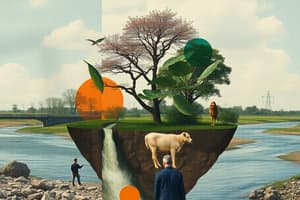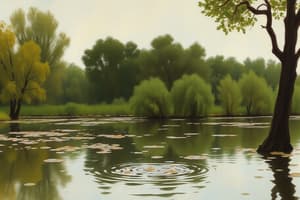Podcast
Questions and Answers
What percentage of worldwide water use is attributed to agricultural purposes?
What percentage of worldwide water use is attributed to agricultural purposes?
- 70% (correct)
- 8%
- 22%
- 43.5%
Which of the following is not considered an industrial use of water?
Which of the following is not considered an industrial use of water?
- Crops irrigation (correct)
- Ore and oil refineries
- Thermal power plants
- Hydroelectric plants
What is the hydropower generation capacity of the Balog-Balog Multi Purpose Project?
What is the hydropower generation capacity of the Balog-Balog Multi Purpose Project?
- 23,000 farmers
- 560 MCM
- 34,410 MW
- 43.5 MW (correct)
Which type of industrial application includes water cooling?
Which type of industrial application includes water cooling?
Which of the following is primarily a residential use of water?
Which of the following is primarily a residential use of water?
What is a primary benefit of environmental water flows?
What is a primary benefit of environmental water flows?
Which of the following sources of water is primarily utilized for recreation?
Which of the following sources of water is primarily utilized for recreation?
Which component is not part of water resources management?
Which component is not part of water resources management?
What is the primary purpose of environmental flows in water resource management?
What is the primary purpose of environmental flows in water resource management?
Which of the following accurately describes the classification of water usage in industrial applications?
Which of the following accurately describes the classification of water usage in industrial applications?
What is a significant challenge regarding fresh water resources globally?
What is a significant challenge regarding fresh water resources globally?
Fish ladders are primarily implemented to achieve which of the following outcomes?
Fish ladders are primarily implemented to achieve which of the following outcomes?
How is fresh water classified in terms of its availability as a resource?
How is fresh water classified in terms of its availability as a resource?
What role does water resources engineering play in managing water systems?
What role does water resources engineering play in managing water systems?
What connection does population growth have on water demand?
What connection does population growth have on water demand?
Which source of fresh water contributes most significantly to reservoirs?
Which source of fresh water contributes most significantly to reservoirs?
What is a key factor driving the increasing demand for water in modern agriculture?
What is a key factor driving the increasing demand for water in modern agriculture?
What technological innovation is likely to be a focus for future water-resources engineers?
What technological innovation is likely to be a focus for future water-resources engineers?
Which of the following is NOT a factor to consider in the feasibility of water resource projects?
Which of the following is NOT a factor to consider in the feasibility of water resource projects?
How has the standard of personal cleanliness affected water demand in modern civilization?
How has the standard of personal cleanliness affected water demand in modern civilization?
What is a significant consequence of industrial progress related to water use?
What is a significant consequence of industrial progress related to water use?
Which aspect of water management involves maintaining environmental flows and habitats?
Which aspect of water management involves maintaining environmental flows and habitats?
What primary concern is being addressed by water resource planning in urban populations?
What primary concern is being addressed by water resource planning in urban populations?
What role do political incentives play in water resources planning?
What role do political incentives play in water resources planning?
Flashcards are hidden until you start studying
Study Notes
Definition and Classification of Water Use
- Water is critical for modern civilization, with demands far exceeding historical usage.
- Cleanliness standards today require significantly more water than in the past.
- Growing populations necessitate increased agricultural land and improved storm drainage, water supply, and sewerage systems.
- Industrial growth leads to heightened water use in processes and electric power production.
Future of Water Resources Engineering
- Future engineers will engage with innovative technologies and concepts in water management.
- Key areas of focus will include wastewater reclamation, weather modification, and land management for enhanced water yield.
- Water-saving techniques and recreational water usage are also on the rise.
Environmental Considerations in Water Management
- Environmental flows (10% of available flow) are essential for maintaining aquatic habitats.
- Fish ladders support ecosystem sustainability by enabling fish passage.
Sources of Fresh Water
- Freshwater sources include groundwater, rivers, lakes, and reservoirs such as Laguna Lake and Angat Reservoir.
- Freshwater is a renewable resource, but supply is diminishing globally.
Water Demand and Supply Challenges
- Water demand often outstrips supply in many regions, exacerbated by rising populations.
- Critical resource under threat, requiring effective water management strategies.
Water Resource Usage
- Water resources are primarily for:
- Agricultural (70% of global water usage)
- Industrial (22% of global water usage)
- Residential (8% of global water usage)
- Recreational
- Environmental activities
Agricultural Water Use
- Essential for irrigation and aquaculture, impacting food security and farmer livelihoods.
- Example project: Balog-Balog Multi-Purpose Project with an irrigation capacity of 34,410 hectares, hydropower generation of 43.5 MW, and a dam storage capacity of 560 million cubic meters.
Industrial Water Use
- Key industrial applications include:
- Hydroelectric plants reliant on dam and river runoff for power generation.
- Thermo-electric power plants using water for cooling (e.g., coal, nuclear, geothermal).
- Chemical processes at ore and oil refineries.
- Water-intensive manufacturing plants utilizing solvents.
Studying That Suits You
Use AI to generate personalized quizzes and flashcards to suit your learning preferences.



